Jaguar XK120
Reviewed by Unique Cars and Parts
Our Rating: 5
Introduction
Designed to be a low-volume dream car rather than a high production motor car, the Jaguar XK120 became an overnight sensation and highly profitable. While most were exported to the USA, there are still examples to be found in Australia and the celebrated "classic" can be purchased at a price.
The Jaguar XK120 Roadster was launched at the 1948 Earls Court Motor Show and was an immediate success. This very stylish car had a top speed over 120 mph (hence the 120 name), and was tremendously good value for money being considerably cheaper and more advanced than any rival. It was a combination of beautiful looks combined with an impressive engine that was to ensure its success.
It was the fist car to feature the all-new double overhead camshaft engine, which in one cubic capacity or another went on to power all Jaguar cars - both saloon and sports, for about forty years. The new 3.4 litre straight six was a silky smooth engine, using twin cams and twin
SU carburettors to develop 160 bhp.
The XK 120 was hugely popular and orders were much higher than Jaguar had anticipated. The first cars featured alloy body panels over an ash frame, but after production of about 200 models jaguar switched to a mass-produced mainly steel body to keep up with demand.
The "120" in XK120 was in fact true of the cars performance, the first model rated at a top speed of 120 mph (193 km/h). Later "SE" (Special Equipment) models came with higher lift cams and twin exhausts that were able to lift the power to 180 bhp. In
1951 a Fixed Head Coupe version was introduced, with a Drophead Coupe joining the range in
1953. Both of these cars featured wind-up windows, external door handles, and a walnut dashboard. A Special Equipment model was available from
1951 with a 180 bhp engine. Production of all models ended in
1954 when the
XK140 was introduced.
Stop Press - 1949
Another world record has fallen to a standard model Jaguar XK 120 Super Sports 3.5 litre (25 h.p.). Last month, one was officially clocked over a measured mile in Belgium at a time-average speed of 132.59 miles per hour. The runs, claimed the fastest ever recorded officially by a standard production car, were timed by Royal Automobile Club 6f Belgium officials, and were made on ordinary pump petrol. In addition to the mile record the Jaguar covered a kilometre (1,093) yds. 22 in.) from a standing start, at an average speed of 74 m.p.h., and a standing mile at an average speed of 86.4 m.p.h.
Jaguar Today and Tomorrow - The XK120 Story
by John Wheelock Freeman (pub. 1954)
TWO spectators at a motor show watched the crowd form around a sleek new prototype roadster. "Cheap publicity stunt," observed one. "That complicated engine would have to cost twice as much if it was going to run right." The other nodded in glum agreement; the Jaguar XK-120, he said, was a farce to any serious-minded auto enthusiast and would doubtless fall apart during its first tryout. The two spectators walked away from the crowd to search for a more genuine car on exhibition.
This suspicious attitude, and the jolt of surprise soon to follow it, are nothing new in the life of
"Bill" Lyons,
Jaguar founder and director. His life has been devoted to surprising people with unbelievable cars. Starting in business as a motorcycle sidecar manufacturer in 1922, he early developed an interest in coach-building, producing special bodies for the little
Austin "Seven" chassis. Nine years after his
Swallow Coachworks first opened,
Lyons engineered and carried out a deal with the Standard Motor Company that today remains a classic for talented audacity. Using Standard chassis and engines, he introduced his first SS cars - expensive looking, dashingly sporty, and so low to the ground that they created a scandal.
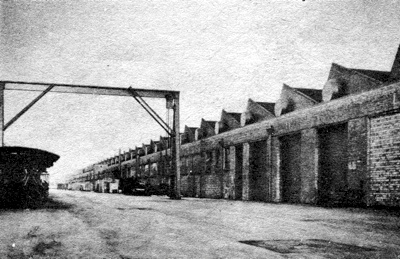 Photo of the Jaguar factory in Coventry, circa 1950.
Photo of the Jaguar factory in Coventry, circa 1950.
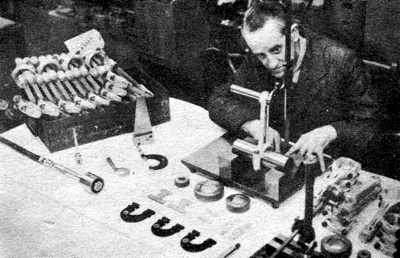
An inspector on the XK-120 production line, checking
con-rod measurments.
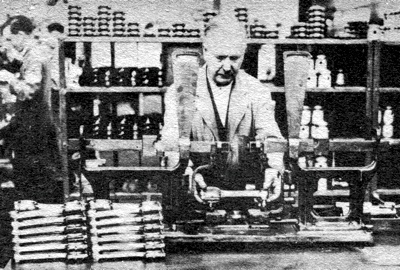
Con-rods being balanced in matched sets of six.
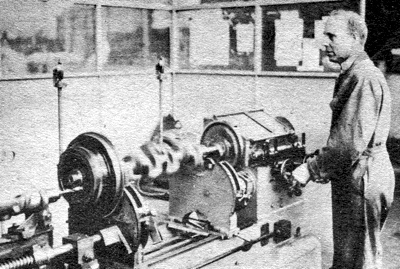
Each crankshaft being individually balanced, then balanced again
as a unit with the flywheel, before fitting.
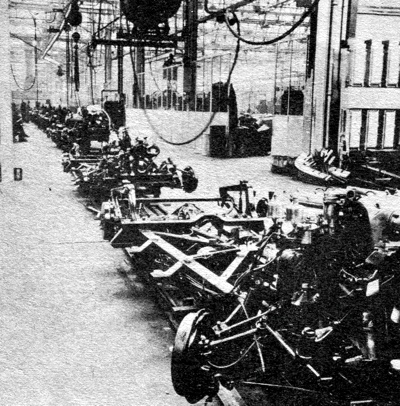
Finished chassis complete with engines, wiating for the body.
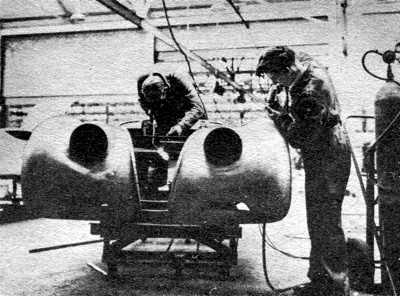
XK120 Roadster body being completed.
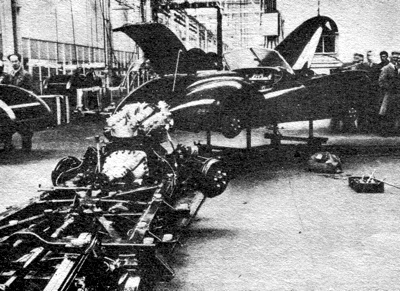
Painted bodies arriving from a separate line,
then being fitted to the chassis.

Tubular chassis for the XK-120-C being built by hand
in a separate workshop.
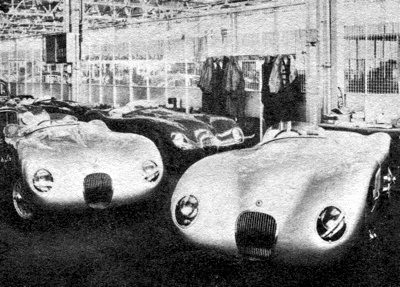
Finished competition Jags awaiting delivery to their owners.
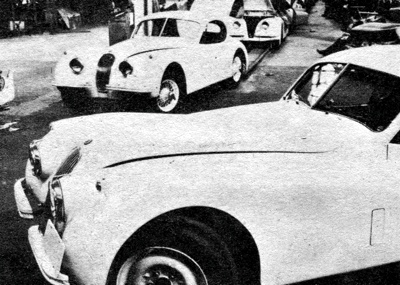
XK 120 Coupe models at final production stage.
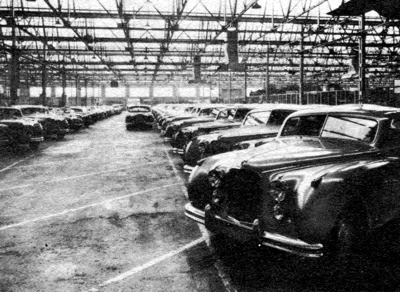
Jaguar Mark VII Sedans waiting shipment to the USA.
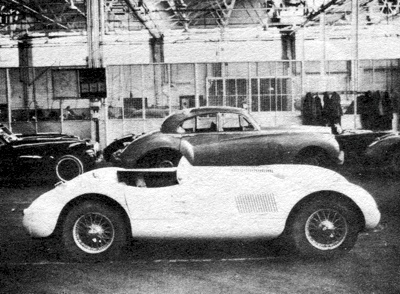
Jaguar XK 120-C in profile. |
From that explosive beginning, the Jaguar company has grown to the point where today it produces a line of cars that are among the best looking, fastest, and most talked-about in the entire world. True, some of the more distinctive and classic features of the older cars have been abandoned in the present-day models, causing some customers to complain that it is no longer possible to choose the Jag rather than some American car for the simple fact that it's different. For each such disgruntled esthete, however, there are two happy purchasers waiting to welcome the British cars' superior workmanship, engineering, and performance.
On the credit side, it should be emphasized that while postwar Jaguars do not duplicate the genuine distinction of the Mark IV's appearance, they have sidestepped the pitfalls of more "modern" design and kept a clean, crisp feeling, devoid of excess chrome or extravagant bulges.
While the current Mark VII sedan resembles a Chevrolet or Chrysler in certain techniques of its body design, it also differs from them in all aspects where their design is worst. Thus the "dollar grin" front is absent; so are the inevitable "phallic symbol" hood ornament, the "sweep-spear" defacing the car's side, and the endless repetition via large chrome lettering of such all-important public data as the car's name, number of cylinders, series and transmission nicknames, etc.
The Development of the Inline Six
And if the traditional lines of Britain's sports car were cast aside, so were a few of its less desirable "traditions" such as spine-shattering hard
suspension, flimsy opaque side curtains, wooden body framework, stiff
steering, and stony seats. Despite the success of the
Mark V series, which superseded the stylish but supposedly anachronistic Mark IV and which had an equally short life of about two years, Jaguar's big drawing card late in 1949 was the XK-120. Originally unveiled as an experimental prototype, it quickly broke all anticipated schedules of public response and, therefore, of production. The story of its steadily growing popularity has become a familiar tribute to the vision and skill of its builders.
During the long development of the new engine, Jaguar's engineers had considered and discarded numerous basic designs. First they rejected further exploitation of the existing pushrod overhead-valve job since it was already close, in the Mark V, to its maximum potentialities. V-type engines were considered and various valve mechanisms were weighed against one another.
It is interesting that the
Chrysler Corporation in America, which was simultaneously carrying on a completely separate experimental program, arrived at the same conclusion as the Jaguar company: the "ideal engine" is a six-cylinder in-line with twin overhead camshafts and hemispherical combustion chambers.
Chrysler found the engine impractical for low i:ost mass production and service, however, and switched to its next favorite, the V-8.
Jaguar forged on alone with one of the most advanced pieces of engineering in production today. The common sense of this venture has proven itself in the fantastic achievements of XK-120 engines in actual operation. First of such achievements was the official run, by a strictly stock XK-120 roadster using ordinary gasoline, at a speed of 132.6 mph on the Jabekke highway in Belgium.
Since then, a stock XK-120 hardtop coupe has run continuously for seven days on the track at Montlhery near Paris, its average speed being substantially over 100 mph. Recent figures from Belgium find the XK-120 bettering its own initial record with a top speed of 141.846 mph, while the Mark VII sedan hit 121.704 and the competition model XK-120-C cleared 148.435.
The Competition XK-120-C
In road racing, the spectacular multiple victories of the competition model at Le Mans, France, in
1951 and
1953 are self-explanatory. Finishing in first and second places, Jaguars in
1953 copped an all-time course record of over 300 laps in the 24-hour race period, the average speed of the winning car being the highest in the history of Le Mans - 106 mph! These racing victories mark a new policy on the part of the Jaguar works - before the war all such achievements were scored at the hands of private owners.
Factory participation has begotten the special competition model XK-120-C, which recently became available in limited numbers to individual customers and which was created exclusively for road racing. The standard engine is modified to produce a peak of 210 hp at 5,800 rpm, as against 160 hp at 5,000 rpm in stock form. Changes include larger
valves and greater valve lift, higher compression (9 to 1), a dual exhaust system, and oversize twin S.U. carburetors with special air cleaners.
Certain of these modifications, along with Rudge-Whitworth wire-spoke wheels, are available on the standard XK-120 model at the nominal figure of $400 extra. The competition model differs chiefly in its tubular frame and light, thoroughly aerodynamic
bodywork. Its operating equipment is confined to that required by K.I.A. regulations, thus omitting weather protection, luggage space, and a conventional windshield. Aside from its engine design and performance, the Jaguar's most astonishing feature - one which even its severest critics will admit - is value for the money.
Retail prices in England (subject to purchase tax) start at £3,164 for the XK-120 roadster. The hardtop and Mark VII are both £3,192, while the XK-120-C racing model is miraculously only £4,186. While some persons, having reservations about Jaguar quality, protest that it's folly to try to make a £10,000 car to sell for one-third that amount, faguar has proven to its admirers that luxury features needn't be the exclusive privilege of a few millionaires.
Perhaps the most remarkable thing about these prices is that the Mark VII, even at its American retail price, competes favorably with the
Cadillac,
Chrysler,
Packard, and
Lincoln. Feature for feature, compared with these American luxury cars, the Jaguar offers at least twice the value for the money. It has a more expensive type of engine, built with as much or greater quality and precision; it has natural woodwork, pleated leather, bucket seats, sun roof, racing-type emergency brake, good four-speed shift on the floor where it should be, and all the comforts of the American luxury cars in question - these things plus adjustable steering wheel and far superior handling and road-holding without loss of smooth riding.
Recently made available with Borg-Warner torque converter for lazy and ignorant drivers, it now stands ready to surpass any Detroit mass produced model. To call this a great achievement would be Number One understatement of the past three years. Sales figures seem to bear out the public awareness of the Mark VII's stupendous qualities - it outsells the less practical sports models two to one. The hardtop coupe, in turn, outsells the less practical open roadster. A convertible version was recently introduced.
It keeps the rakishness of the roadster but introduces a better looking top with roll-up side windows and woodwork instead of leather on dashboard and door fittings. Although somewhat higher in price, it answers many of the objections of nonracing owners to the roadster's austerity. It would be unwise to assume that this excellent bargain, welcome as it is in a world starved for readily available sports cars, is devoid of faults. Quarters in the XK-120 are pretty cramped for any driver over six feet tall and there's no room behind the seat for children, dogs, and extra baggage (even the little Porsche has this).
Mechanical Criticism's
For the family man. it's a choice between this bachelor's car and the hefty dimensions of the Mark VII; there's no moderately sized two-door four-seater in between which retains the sporting characteristics without selling out completely to living-room accommodations. Somewhat more serious are the mechanical criticisms leveled at the XK-120. The car's inveterate tendency toward overheating in traffic may or may not have been alleviated by the factory's recent switch to a six-bladed fan.
The relatively stiff gearbox action and long shift travel as compared, say, to the soul-satisfying "click-click" of an MG gearbox, fail to please a number of drivers, and most are genuinely annoyed by the protruding horn button, which obstructs steering. Periodically, one hears complaints about the brakes, although these seem superb in normal nonracing use. Finally, it's the opinion of many - including one of our most expert American race drivers, from his first-hand experience - that the stock Jaguar XK-120, like most British, cars, doesn't measure up to Italian and French products when it comes to road-holding and cornering.
To the Jaguar enthusiast, however, such complaints fade away behind the sheer joy of owning and operating such an exciting vehicle. Where else, he'll ask you, could you get half so much for less than a fortune? It takes but a moment to answer this question - and become a Jag booster yourself. Jaguar's production schedule and methods don't allow for the laborious hand fitting found on the world's most expensive cars, but a surprising degree of care does go into each engine.
Under existing operations, about forty engines can be produced daily; average weekly car output is around 250 units. Numerous shortages complicate production. The basic engine block and aluminum-alloy head are cast for Jaguar by someone else. Jaguar workers spend an average of four hours machining each crankshaft to close tolerances. First balanced separately, the crankshaft, flywheel, and clutch are later balanced together.
Damage Means Dismissal
Cheerful signs throughout the factory, such as "Damage Means Dismissal," remind workers of their devotion to quality. Each engine is given a three-hour preliminary bench run, then tested for two hours; rejections are made on an exacting basis. Jaguar believes itself to be the only quantity producer that reams a perfect fit for each piston with its own gudgeon pin. Bodywork for the standard series is built by an independent manufacturer, then fitted to the chassis and finished inside by Jaguar.
As on most British cars, details of carpeting and upholstery are handled by skilled specialists. Jaguar has had trouble. however, getting woodwork hnished to its - and its customers' - satisfaction, a problem that suggests but one of the many headaches besetting a prosperous and growing company. Bodies for the XK-120-C, series are assembled in a special part of the shop set aside for the limited production of these cars. In audition to its own work, the Jaguar factory has a government contract to rebuild Rolls-Royce V-12 Merlin aircraft engines - a trust which indicates the level of work expected from Jaguar.
Happy as they are showing their tailpipes to
Oldsmobiles, America's Jaguar owners can't help wondering what their favorite factory plans to do next. While it wouldn't be wise to put any money on a guess as to the future exploits of Bill Lyons, master of makirtg people's jaws drop, you could safely bet on this inside lead: it'll be a thoroughly kept secret until the boys at Jag are ready. Barring a global catastrophe in the next few months, however, it's fun to imagine what might happen if the smaller XK engine, a four-cylinder job designed to compete in the 2.5-litre class, were finally put into production; or if the rumored 4.5-litre fire-eating monster is likely to appear.
Mr. Lyons isn't one to rest long on his laurels, and the research laboratories doubtless contain some enticing morsels for the sports-car lover's palate. Whatever comes next, it's bound to be as good as you'd expect from a firm whose policy has been to capitalize on the impossible. From the bird-cage of the Swallow coach-works to the Jaguar's den has been an exciting hunt - and the game gets bigger all the time.
Jaguar XK 120 Identification
The first roadsters were hand-built with aluminium bodies on ash frames mounted on modified Jaguar Mark V chassis, these being constructed between late 1948 and early
1950. To meet demand, and beginning with the 1950 model year, all subsequent XK120s were mass-produced with pressed-steel bodies. They retained aluminium doors, bonnet, and boot lid. The DHC and FHC versions, more luxuriously appointed than the roadsters, had wind-up windows and also wood veneers on the dashboard and interior door caps.
With alloy
cylinder head and twin side-draft SU carburetors, the dual overhead-cam 3.4 litre straight-6 XK engine was comparatively advanced for a mass-produced unit of the time. With standard 8:1 compression ratio it developed 160 bhp (119 kW), using 80 octane fuel. Most of the early cars were exported; a 7:1 low-compression version, with consequently reduced performance, was reserved for the UK market, where the post-war austerity measures then in force restricted buyers to 70 octane "Pool petrol".
The Jaguar factory, with access to 80 octane fuel, provided roadsters with the higher compression ratio to the press. Journalists could then test the model's optimum performance in Belgium, on a long, straight stretch of road between Jabbeke and Ostend. The XK engine's basic design, later modified into 3.8 and 4.2 litre versions, survived into the late 1980s.
ALFIN Brakes
All XK120s had independent torsion bar front
suspension, semi-elliptic leaf
springs at the rear, recirculating ball
steering, telescopically adjustable
steering column, and all-round 12 inch drum
brakes that were prone to fade. Some cars were fitted with Alfin (ALuminium FINned) brake drums to help overcome the fade.
The roadster's lightweight canvas top and detachable sidescreens stowed out of sight behind the seats, and its barchetta-style doors had no external handles; instead there was an interior pull-cord which was accessible through a flap in the sidescreens when the weather equipment was in place. The windscreen could be removed for aeroscreens to be fitted.
The drophead coupe (DHC) had a padded, lined canvas top, which folded onto the rear deck behind the seats when retracted, and roll-up windows with opening quarter lights. The flat glass two-piece windscreen was set in a steel frame that was integrated with the
body and painted the same colour.
Dashboards and door-caps in both the DHC and the closed coupe (FHC) were wood-veneered, whereas the more spartan roadster's were leather-trimmed. All models had removable spats ("fender skirts" in America) covering the rear wheel arches, which enhanced the streamlined look. On cars fitted with optional centre-lock wire wheels (available from
1951), the spats were omitted as they gave insufficient clearance for the chromed, two-eared Rudge-Whitworth knockoff hubs. In addition to wire wheels, upgrades on the Special Equipment, or SE, version (called the M version in the United States) included increased power, stiffer suspension and dual exhaust system.



